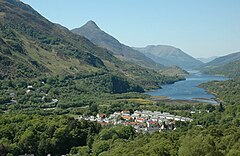Kinlochleven
Kinlochleven
|
|
|---|---|
 Kinlochleven |
|
| Kinlochleven shown within the Lochaber area | |
| OS grid reference | NN186618 |
| Council area | |
| Country | Scotland |
| Sovereign state | United Kingdom |
| Post town | Kinlochleven |
| Postcode district | PH50 4 |
| Police | Scottish |
| Fire | Scottish |
| Ambulance | Scottish |
| EU Parliament | Scotland |
Kinlochleven (/ˌkɪnlɒxˈliːvən/) (Scottish Gaelic: Ceann Loch Lìobhann) is a village in Lochaber, in the Scottish Highlands and lies at the eastern end of Loch Leven. To the north lie the Mamores ridge; to the south lie the mountains flanking Glen Coe.
The village was formed from two previously separate small communities - Kinlochmore to the north of the River Leven in Inverness-shire and Kinlochbeg to the south of the Leven in Argyll - following the construction of an aluminium smelter and associated housing for its employees. The processing plant was powered by a hydroelectric scheme situated in the mountains above, and made Kinlochleven the first village in the world to have every house connected to electricity, coining the phrase "The Electric Village". In 1991, the village (according to annual census returns) had just over 1000 inhabitants in some 420 households. Today it is a notable tourist destination and centre for mountain pursuits.
Work on the dam and water supply system began in 1905 and was completed in 1907. The hydro-electric scheme was constructed for the British Aluminium Company and was designed by engineer brothers Patrick and Charles Meik. The chief assistant resident engineer on the project was a young William Halcrow. The scheme involved the construction of a gravity dam over 914 m long (the longest in the Highlands) and 27 m high, creating the Blackwater Reservoir. It was built at an elevation of over 305 m in rugged and almost inaccessible terrain, and involved the construction of some 6 km of concrete aqueduct and nearly 13 km of steel pipe. It has been described as the last major creation of the traditional 'navvy' whose activities in the construction of canals and railways left an indelible mark on the British countryside.
...
Wikipedia

